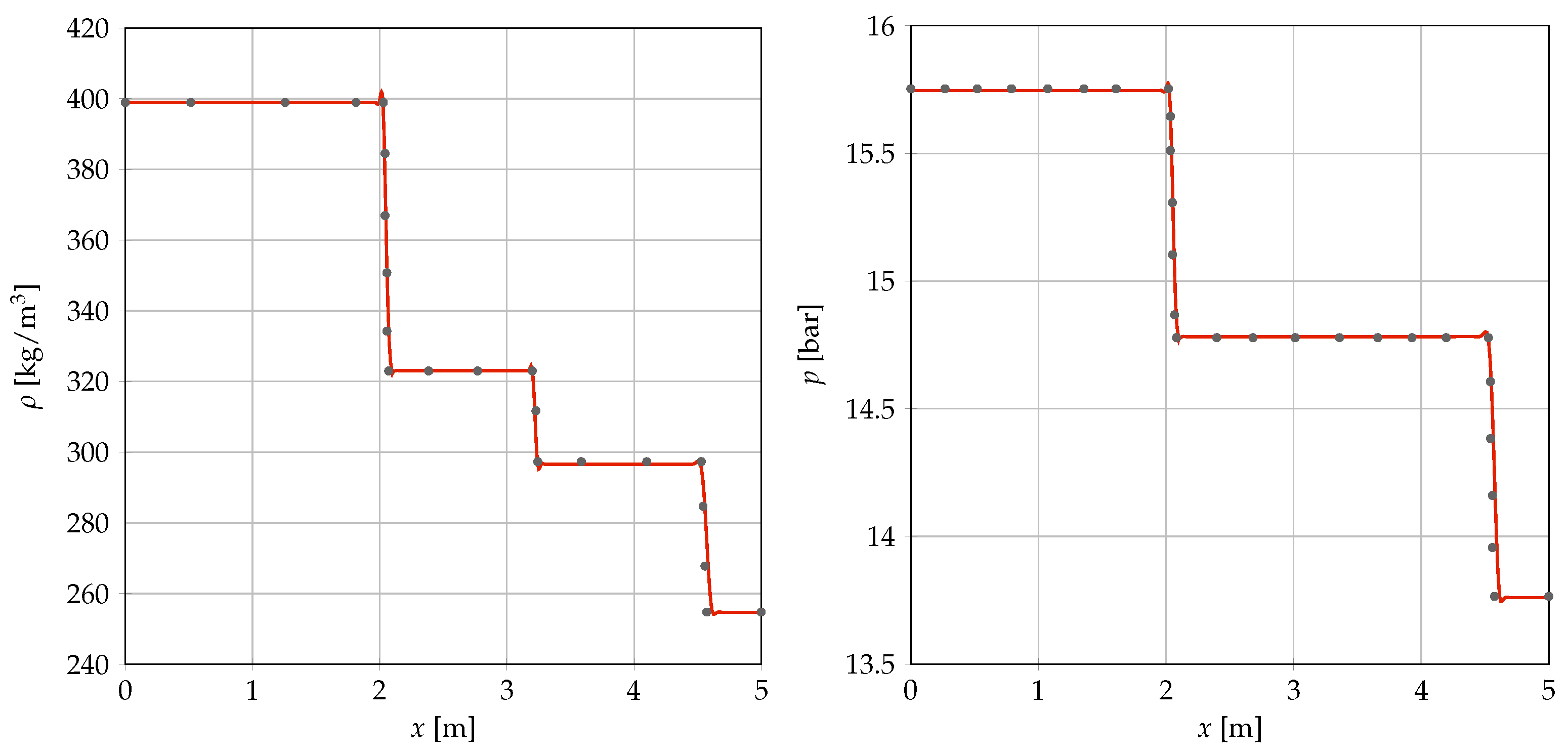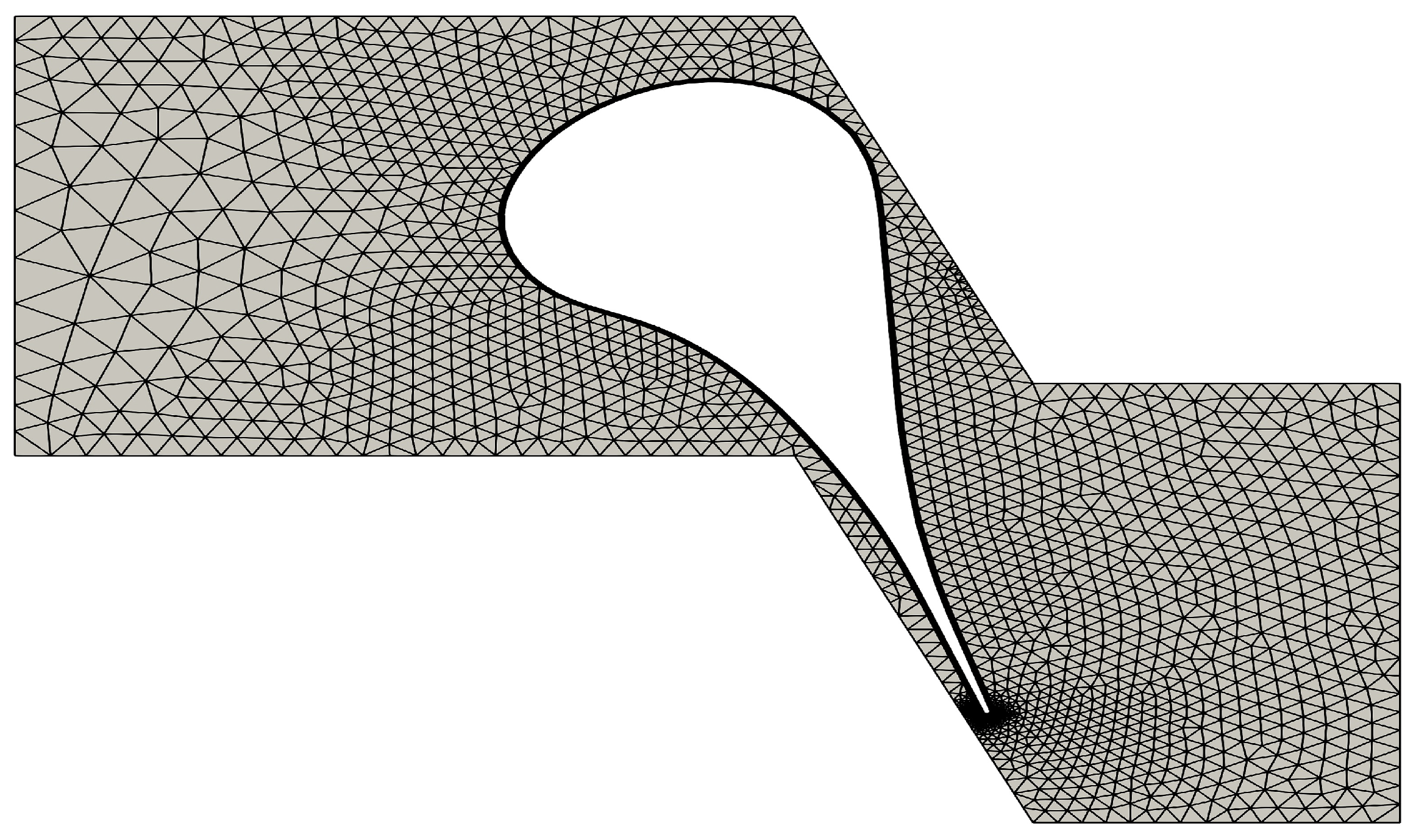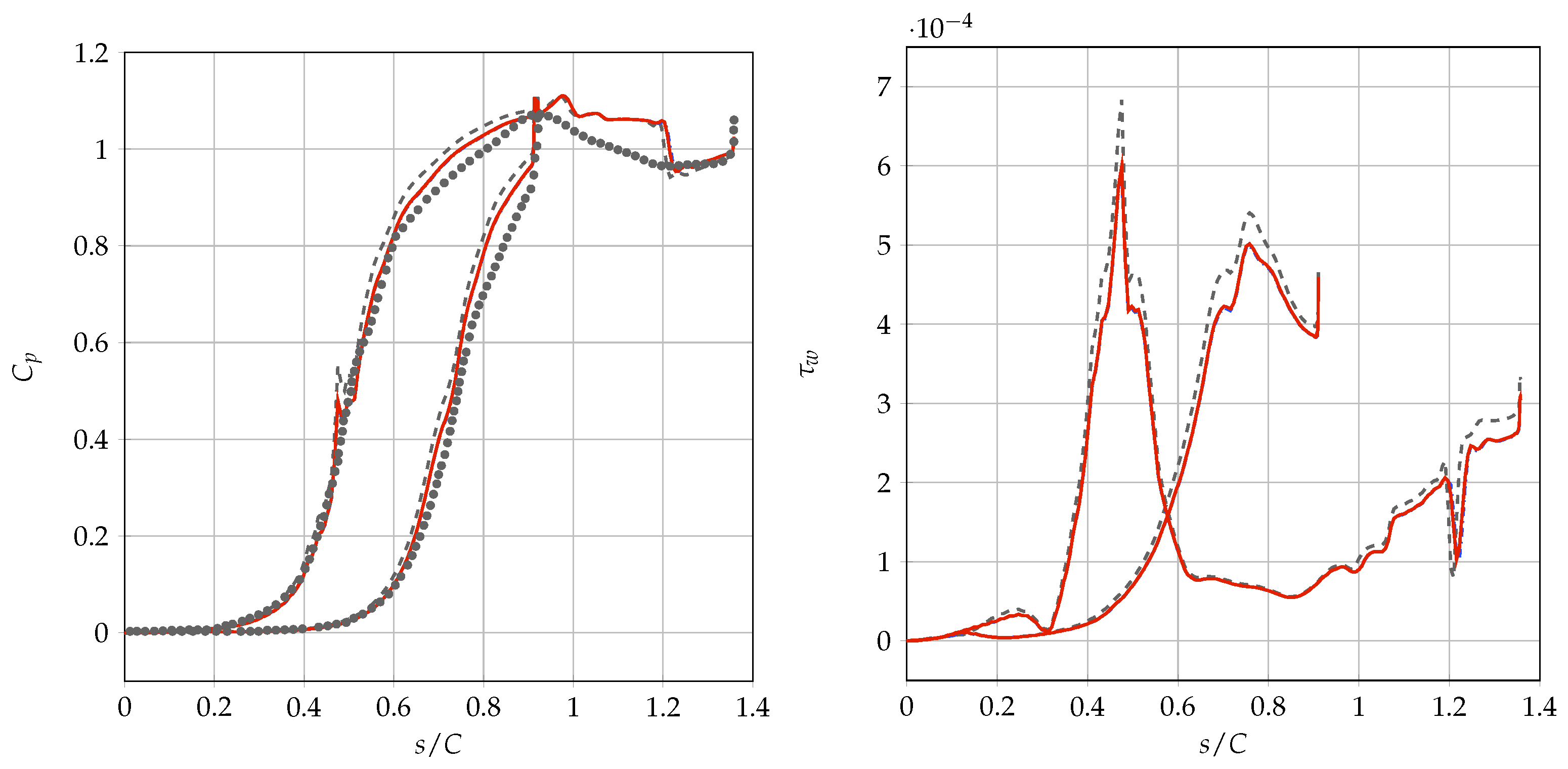On the Development of an Implicit Discontinuous Galerkin Solver for Turbulent Real Gas Flows
Abstract
1. Introduction
2. Discontinuous Galerkin Solver
2.1. Governing Equations
2.2. Spatial Discretization
2.3. Temporal Discretization
3. Thermodynamic Models
3.1. Peng–Robinson and van der Waals Models
3.2. Span–Wagner Model
3.3. Derivatives
3.4. Numerical Fluxes and Boundary Conditions
4. Results
4.1. Unsteady Shock Tube
4.2. Supersonic Wedge
4.3. ORC Turbine Nozzle
5. Conclusions and Future Works
Author Contributions
Funding
Data Availability Statement
Conflicts of Interest
Abbreviations
| NICFD | Non ideal compressible fluid dynamics |
| ORC | Organic Rankine cycle |
| CCS | Carbon capture and storage |
| EoS | Equation of state |
| CEoS | Cubic equation of state |
| MEoS | Multiparameter equation of state |
| dG | Discontinuous Galerkin |
| vdW | van der Waals |
| PR | Peng–Robinson |
| SW | Span–Wagner |
| MH | Martin–Hou |
| FEM | Finite element method |
| FVM | Finite volume method |
| dG-FEM | Discontinuous Galerkin finite element method |
| LBE | Linearized backward Euler |
| AD | Automatic differentiation |
| GMRES | Generalized minimal residual |
| ASM | Additive Schwarz method |
| FD | Finite differences |
| RANS | Reynolds-averaged Navier–Stokes |
| ODE | Ordinary differential equation |
References
- Van der Waals, J. The equation of state for gases and liquids. Nobel Lect. Phys. 1910, 1, 254–265. [Google Scholar]
- Peng, D.; Robinson, D. A New Two-Constant Equation of State. Ind. Eng. Chem. Fundam. 1976, 15, 59–64. [Google Scholar] [CrossRef]
- Span, R.; Wagner, W. A New Equation of State for Carbon Dioxide Covering the Fluid Region from the Triple-Point Temperature to 1100 K at Pressures up to 800 MPa. J. Phys. Chem. Ref. Data 1996, 25, 1509–1596. [Google Scholar] [CrossRef]
- Guardone, A.; Vigevano, L.; Argrow, B.M. Assessment of thermodynamic models for dense gas dynamics. Phys. Fluids 2004, 16, 3878–3887. [Google Scholar] [CrossRef]
- Pini, M.; Vitale, S.; Colonna, P.; Gori, G.; Guardone, A.; Economon, T.; Alonso, J.; Palacios, F. SU2: The Open-Source Software for Non-ideal Compressible Flows. J. Phys. Conf. Ser. 2017, 821, 012013. [Google Scholar] [CrossRef]
- Colonna, P.; Harinck, J.; Rebay, S.; Guardone, A. Real-Gas Effects in Organic Rankine Cycle Turbine Nozzles. J. Propuls. Power 2008, 24, 282–294. [Google Scholar] [CrossRef]
- Chung, T.H.; Ajlan, M.; Lee, L.L.; Starling, K.E. Generalized multiparameter correlation for nonpolar and polar fluid transport properties. Ind. Eng. Chem. Res. 1988, 27, 671–679. [Google Scholar] [CrossRef]
- Roe, P. Approximate Riemann solvers, parameter vectors, and difference schemes. J. Comput. Phys. 1981, 43, 357–372. [Google Scholar] [CrossRef]
- Vinokur, M.; Montagné, J. Generalized flux-vector splitting and Roe average for an equilibrium real gas. J. Comput. Phys. 1990, 89, 276–300. [Google Scholar] [CrossRef]
- Glaister, P. An approximate linearised riemann solver for the Euler equations for real gases. J. Comput. Phys. 1988, 74, 382–408. [Google Scholar] [CrossRef]
- Colonna, P.; Rebay, S. Numerical simulation of dense gas flows on unstructured grids with an implicit high resolution upwind Euler solver. Int. J. Numer. Methods Fluids 2004, 46, 735–765. [Google Scholar] [CrossRef]
- Bassi, F.; Botti, L.; Colombo, A.; Crivellini, A.; Ghidoni, A.; Nigro, A.; Rebay, S. Time Integration in the Discontinuous Galerkin Code MIGALE—Unsteady Problems. In IDIHOM: Industrialization of High-Order Methods—A Top-Down Approach: Results of a Collaborative Research Project Funded by the European Union, 2010–2014; Springer International Publishing: Cham, Switzerland, 2015; pp. 205–230. [Google Scholar] [CrossRef]
- Bassi, F.; Botti, L.; Colombo, A.; Crivellini, A.; De Bartolo, C.; Franchina, N.; Ghidoni, A.; Rebay, S. Time Integration in the Discontinuous Galerkin Code MIGALE—Steady Problems. In IDIHOM: Industrialization of High-Order Methods—A Top-Down Approach: Results of a Collaborative Research Project Funded by the European Union, 2010–2014; Springer International Publishing: Cham, Switzerland, 2015; pp. 179–204. [Google Scholar] [CrossRef]
- Bassi, F.; Botti, L.; Colombo, A.; Crivellini, A.; Franchina, N.; Ghidoni, A. Assessment of a high-order accurate Discontinuous Galerkin method for turbomachinery flows. Int. J. Comput. Fluid Dyn. 2016, 30, 307–328. [Google Scholar] [CrossRef]
- Hascoet, L.; Pascual, V. The Tapenade Automatic Differentiation Tool: Principles, Model, and Specification. ACM Trans. Math. Softw. 2013, 39, 20. [Google Scholar] [CrossRef]
- Wilcox, D.C. Turbulence Modelling for CFD; DCW Industries Inc.: La Cañada, CA, USA, 2006. [Google Scholar]
- Rumsey, C.L. Compressibility Considerations for k-w Turbulence Models in Hypersonic Boundary-Layer Applications. J. Spacecr. Rocket. 2010, 47, 11–20. [Google Scholar] [CrossRef]
- Bassi, F.; Rebay, S.; Mariotti, G.; Pedinotti, S.; Savini, M. A high-order accurate discontinuous finite element method for inviscid and viscous turbomachinery flows. In Proceedings of the 2nd European Conference on Turbomachinery Fluid Dynamics and Thermodynamics, Antwerpen, Belgium, 5–7 March 1997; pp. 99–109. [Google Scholar]
- Arnold, D.N.; Brezzi, F.; Cockburn, B.; Marini, L.D. Unified Analysis of Discontinuous Galerkin Methods for Elliptic Problems. SIAM J. Numer. Anal. 2002, 39, 1749–1779. [Google Scholar] [CrossRef]
- Bassi, F.; Botti, L.; Colombo, A.; Crivellini, A.; Franchina, N.; Ghidoni, A.; Rebay, S. Very High-Order Accurate Discontinuous Galerkin Computation of Transonic Turbulent Flows on Aeronautical Configurations. In ADIGMA—A European Initiative on the Development of Adaptive Higher-Order Variational Methods for Aerospace Applications; Springer: Berlin/Heidelberg, Germany, 2010; pp. 25–38. [Google Scholar]
- Bassi, F.; Ghidoni, A.; Perbellini, A.; Rebay, S.; Crivellini, A.; Franchina, N.; Savini, M. A high-order Discontinuous Galerkin solver for the incompressible RANS and k–ω turbulence model equations. Comput. Fluids 2014, 98, 54–68. [Google Scholar] [CrossRef]
- PETSc Web Page. 2018. Available online: https://petsc.org (accessed on 2 January 2023).
- Zou, Q. GMRES algorithms over 35 years. Appl. Math. Comput. 2023, 445, 127869. [Google Scholar] [CrossRef]
- Pawlowski, R.P.; Shadid, J.N.; Simonis, J.P.; Walker, H.F. Globalization Techniques for Newton–Krylov Methods and Applications to the Fully Coupled Solution of the Navier–Stokes Equations. SIAM Rev. 2006, 48, 700–721. [Google Scholar] [CrossRef]
- Pearson, J.W.; Pestana, J. Preconditioners for Krylov subspace methods: An overview. GAMM-Mitteilungen 2020, 43, e202000015. [Google Scholar] [CrossRef]
- Yildirim, A.; Kenway, G.K.; Mader, C.A.; Martins, J.R. A Jacobian-free approximate Newton–Krylov startup strategy for RANS simulations. J. Comput. Phys. 2019, 397, 108741. [Google Scholar] [CrossRef]
- Cai, X.C.; Sarkis, M. A Restricted Additive Schwarz Preconditioner for General Sparse Linear Systems. SIAM J. Sci. Comput. 1999, 21, 792–797. [Google Scholar] [CrossRef]
- Martin, J.J. Cubic Equations of State-Which? Ind. Eng. Chem. Fundam. 1979, 18, 81–97. [Google Scholar] [CrossRef]
- Callen, H.B. Thermodynamics and an Introduction to Thermostatistics, 2nd ed.; Wiley: Hoboken, NJ, USA, 1985. [Google Scholar]
- Reynolds, W. Thermodynamic Properties in SI: Graphs, Tables, and Computational Equations for Forty Substances; Stanford University, Department of Mechanical Engineering: Stanford, CA, USA, 1979. [Google Scholar]
- Poling, B.; Prausnitz, J.; O’Connell, J. The Properties of Gases and Liquids 5E; McGraw-Hill Education: Columbus, OH, USA, 2000. [Google Scholar]
- Hanimann, L.; Mangani, L.; Casartelli, E.; Vogt, D.M.; Darwish, M. Real Gas Models in Coupled Algorithms Numerical Recipes and Thermophysical Relations. Int. J. Turbomach. Propuls. Power 2020, 5, 20. [Google Scholar] [CrossRef]
- Cramer, M. Negative nonlinearity in selected fluorocarbons. Phys. Fluids A Fluid Dyn. 1989, 1, 1894–1897. [Google Scholar] [CrossRef]
- Argrow, B.M. Computational analysis of dense gas shock tube flow. Shock Waves 1996, 6, 241–248. [Google Scholar] [CrossRef]
- Lawal, A.S. A consistent rule for selecting roots in cubic equations of state. Ind. Eng. Chem. Res. 1987, 26, 857–859. [Google Scholar] [CrossRef]
- Span, R. Multiparameter Equations of State; Springer: Berlin/Heidelberg, Germany, 2000. [Google Scholar] [CrossRef]
- Aly, F.A.; Lee, L.L. Self-consistent equations for calculating the ideal gas heat capacity, enthalpy, and entropy. Fluid Phase Equilibria 1981, 6, 169–179. [Google Scholar] [CrossRef]
- Thorade, M.; Saadat, A. Partial derivatives of thermodynamic state properties for dynamic simulation. Environ. Earth Sci. 2013, 70, 3497–3503. [Google Scholar] [CrossRef]
- Cinnella, P. Roe-type schemes for dense gas flow computations. Comput. Fluids 2006, 35, 1264–1281. [Google Scholar] [CrossRef]
- Liu, B.; Wu, Y.; Guo, J.; Zhang, H.; Niu, J.; Li, F. Finite difference Jacobian based Newton–Krylov coupling method for solving multi-physics nonlinear system of nuclear reactor. Ann. Nucl. Energy 2020, 148, 107670. [Google Scholar] [CrossRef]
- Colonna, P.; Nannan, N.; Guardone, A. Multiparameter equations of state for siloxanes: [(CH3)3-Si-O1/2]2-[O-Si-(CH3)2]i=1,...,3, and [O-Si-(CH3)2]6. Fluid Phase Equilibria 2008, 263, 115–130. [Google Scholar] [CrossRef]





 Colonna et al. [6] 2D Euler,
Colonna et al. [6] 2D Euler,  RANS IG EoS,
RANS IG EoS,  RANS PR EoS,
RANS PR EoS,  RANS SW EoS.
RANS SW EoS.
 Colonna et al. [6] 2D Euler,
Colonna et al. [6] 2D Euler,  RANS IG EoS,
RANS IG EoS,  RANS PR EoS,
RANS PR EoS,  RANS SW EoS.
RANS SW EoS.
 RANS IG EoS,
RANS IG EoS,  RANS PR EoS,
RANS PR EoS,  RANS SW EoS.
RANS SW EoS.
 RANS IG EoS,
RANS IG EoS,  RANS PR EoS,
RANS PR EoS,  RANS SW EoS.
RANS SW EoS.
| van der Waals | Peng–Robinson | |
|---|---|---|
| A | a | |
| B | b | b |
| C | b | |
| D | b | |
| a | ( | ( |
| b | R | R |
| h | 0 | 0.37464 + 1.54226 − 0.26992 |
| 1 |
| 2D Inviscid Convective Flux | |||
|---|---|---|---|
| Number of calls | AD [s] | FD 1st order [s] | FD 2nd order [s] |
| 100,000 | 0.141 | 0.172 | 0.281 |
| 3D Turbulent Diffusive Flux | |||
| Number of calls | AD [s] | FD 1st order [s] | FD 2nd order [s] |
| 100,000 | 0.344 | 0.531 | 0.859 |
| Side | p [bar] | [kg/m3] | [K] |
|---|---|---|---|
| Left | 15.746 | 398.883 | 632.01 |
| Right | 13.760 | 254.712 | 634.98 |
| Elements | Degree | [] | Error [%] | |
|---|---|---|---|---|
| 42,400 | 113,067 | 26.913 | 13.164 | |
| 2650 | 106,000 | 29.396 | 5.150 | |
| 42,400 | 678,400 | 30.763 | 0.742 |
| Model | [] | ||
|---|---|---|---|
| IG | 1.928 | 0.255 | |
| PR | 1.892 | 0.367 | |
| SW | 1.893 | 0.364 |
Disclaimer/Publisher’s Note: The statements, opinions and data contained in all publications are solely those of the individual author(s) and contributor(s) and not of MDPI and/or the editor(s). MDPI and/or the editor(s) disclaim responsibility for any injury to people or property resulting from any ideas, methods, instructions or products referred to in the content. |
© 2023 by the authors. Licensee MDPI, Basel, Switzerland. This article is an open access article distributed under the terms and conditions of the Creative Commons Attribution (CC BY) license (https://creativecommons.org/licenses/by/4.0/).
Share and Cite
Mantecca, E.; Colombo, A.; Ghidoni, A.; Noventa, G.; Pasquale, D.; Rebay, S. On the Development of an Implicit Discontinuous Galerkin Solver for Turbulent Real Gas Flows. Fluids 2023, 8, 117. https://doi.org/10.3390/fluids8040117
Mantecca E, Colombo A, Ghidoni A, Noventa G, Pasquale D, Rebay S. On the Development of an Implicit Discontinuous Galerkin Solver for Turbulent Real Gas Flows. Fluids. 2023; 8(4):117. https://doi.org/10.3390/fluids8040117
Chicago/Turabian StyleMantecca, Edoardo, Alessandro Colombo, Antonio Ghidoni, Gianmaria Noventa, David Pasquale, and Stefano Rebay. 2023. "On the Development of an Implicit Discontinuous Galerkin Solver for Turbulent Real Gas Flows" Fluids 8, no. 4: 117. https://doi.org/10.3390/fluids8040117
APA StyleMantecca, E., Colombo, A., Ghidoni, A., Noventa, G., Pasquale, D., & Rebay, S. (2023). On the Development of an Implicit Discontinuous Galerkin Solver for Turbulent Real Gas Flows. Fluids, 8(4), 117. https://doi.org/10.3390/fluids8040117









